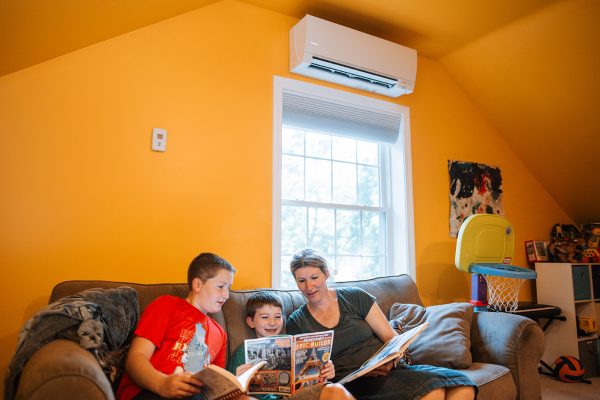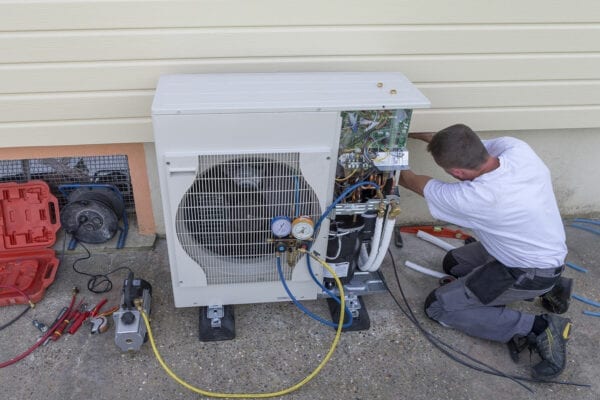How could using more electricity lower electricity rates? Keep reading to find out.
On April 23, 2025, the Maine Public Utilities Commission approved a new three-year investment plan from the Efficiency Maine Trust (Efficiency Maine) that will curb pollution and make our state more efficient and more affordable.
For decades, energy efficiency has been proven to be one of the least-expensive ways to lower energy costs, increase comfort, and reduce pollution. The cheapest kilowatt-hour is the one that’s never used, as the saying goes.
In our cold-weather, rural state, energy use is high and our homes are older, making efficiency much more impactful. This is why the Natural Resources Council of Maine, alongside many partners, helped to establish Efficiency Maine in 2009. Since then, the Trust has been recognized widely for its success in conservation, ranked top in the nation for its programs to accelerate the adoption of clean, affordable electric technologies that shift homes and businesses away from expensive fossil fuels. The agency has already helped save Maine homes and businesses billions of dollars in energy costs with heat pumps, weatherization, and more efficient appliances.
The Opportunity of Beneficial Electrification

Photo courtesy of ReVision Energy
In more recent years, a new opportunity has emerged called “Beneficial Electrification” that has the potential to improve the quality of life for residents across our state. Here’s how it works in a nutshell.
New electric heating and cooking appliances and technologies are much more efficient than oil and gas furnaces or boilers at getting the same result. For example, heat pumps transfer heat instead of creating it, meaning they can turn one unit of energy input into three to four units of heat in a home or business. Newer induction stoves heat pots and pans directly through magnetism, losing less heat to the surrounding air.
Electric vehicles (EVs) are more than three times more efficient on average than gas or diesel cars in turning energy into propulsion. In contrast, burning methane (natural gas), propane, or heating oil are limited by physics to a 1:1 ratio in theory. In practice, due to factors like combustion inefficiencies and heat loss, actual efficiency is lower.
Because of this, operating electric appliances is usually cheaper for households and businesses, as well as more efficient.
Electric bills have two major parts: supply and delivery.
- Supply costs depend on how much electricity is needed and how much those resources cost. In New England, overreliance on natural gas drives up our supply costs, especially when demand is high on hot summer or cold winter days. We can reduce those “peaks” through energy efficiency, as well as technologies and programs to shift use to lower-demand times of day.
- Delivery or transmission and distribution costs are mostly fixed. It’s the cost of the system that’s been built over decades. And the cost is largely split up based on usage. The electric grid is complex, but here’s a very simple way to think about it: if we have a $100 electric system and split the cost between 100 kilowatt-hours (kWh) of use, that would be $1/kWh. But if we add, for example, a few heat pumps and electric vehicles to our imaginary system and now we share the cost over 200 kWh, our system cost per kWh, or rate, would be cut in half to 50 cents/kWh!
Back in the real world, things are much more complicated, but the fundamental truth still holds: if we trade more expensive fossil fuel heating and vehicles for more efficient and affordable electric technologies, reduce those times of maximum demand, and at the same time spread the costs of the electric system across a broader base of electricity use, we can actually lower energy costs in three different ways.
A New Plan for Investing in Our Future

Heat pump installation
Efficiency Maine’s three-year plan embraces the promise of beneficial electrification, among many other innovative programs. The plan weaves together multiple sources of funding, including from the Public Utilities Commission through rates, federal programs, and funding from the regional grid operator and the Regional Greenhouse Gas Initiative (RGGI). With those funds, they offer innovative financial solutions for energy projects through the Efficiency Maine Green Bank; cutting-edge approaches to using electric demand flexibility to save ratepayers money and avoid expensive grid upgrades; and continuing the build-out of a statewide EV charging network, among many others.
The plan, which covers the years 2026-2028, includes smart investments to protect our environment for future generations by reducing 330 million tons of CO2 emissions, shaving 137 megawatts off our peak load, heating an additional 38,000 homes entirely with heat pumps, weatherizing 9,900 more homes across Maine, and suppressing electric rates statewide by more than $490 million.
In recent years, Efficiency Maine has increased its focus on reaching low- and moderate-income households through their programs. This is especially important as in Maine, high energy burdens hit lower-income Mainers the hardest. Overall, every dollar spent through Efficiency Maine’s programs will yield $3.70 in savings back to the state’s economy.
Tackling climate change, addressing the equity gap in our energy system—where working families bear too much of the burden, and investing in clean-energy technologies is an unabashed good for Maine. Efficiency Maine’s plan shows how these investments not only benefit families and local businesses by lowering their energy costs but also benefit our whole state by holding down electricity rates and reducing the pollution that harms our health and fuels climate change.
—Jack Shapiro, NRCM Climate & Clean Energy Director











Leave a Reply